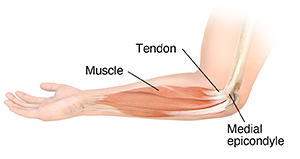Understanding Medial Epicondylitis
Several muscles attach to the arm at the elbow joint. The tough bands of tissue that attach muscle to bones are called tendons. The bone in the upper arm has knobs on the farthest end called epicondyles. Tendons attach some arm muscles to these knobs. The tissues in this area can become irritated.
Epicondylitis is the medical term for a painful, inflamed elbow over the epicondyle. Medial refers to the inner side of the elbow. Medial epicondylitis is sometimes called “golfer’s elbow.”

How to say it
MEE-dee-uhl eh-pih-KOHN-dih-li-tihs
Causes of medial epicondylitis
A painful inner elbow may be caused by:
-
Using an elbow or hand the same way over and over
-
Using poor form or too much force in a sport such as golf, tennis, or baseball
-
Lifting too heavy a weight
-
Other injuries to the arm or elbow
Symptoms of medial epicondylitis
-
Pain or tenderness on the inside of the elbow that may travel down the forearm
-
Pain when moving the wrist
-
Pain or weakness when gripping something
-
A crackling sound or grating feeling when moving the elbow
Treatment for medial epicondylitis
Treatments may include:
-
Avoiding or changing the action that caused the problem. This helps prevent irritating the tissues more.
-
Prescription or over-the-counter medicines. These help reduce inflammation, swelling, and pain.
-
Braces. A counter-force brace can help reduce tendon strain. This allows the joint to heal.
-
Cold or heat packs. These help reduce pain and swelling.
-
Stretching and other exercises. These improve flexibility and strength.
-
Physical therapy. This may include exercises or other treatments.
-
Injections of medicine. This may relieve symptoms.
If other treatments don't relieve symptoms, you may need surgery.
Possible complications
If you don’t give your elbow time to heal, symptoms may return or get worse. Follow your healthcare provider’s instructions on resting and treating your elbow.
When to call your healthcare provider
Call your healthcare provider right away if you have any of these:
-
Fever of 100.4°F (38°C) or higher, or as directed by your provider
-
Chills
-
Redness, swelling, or warmth that gets worse
-
Symptoms that don’t get better with prescribed medicines, or get worse
-
New symptoms
© 2000-2025 The StayWell Company, LLC. All rights reserved. This information is not intended as a substitute for professional medical care. Always follow your healthcare professional's instructions.